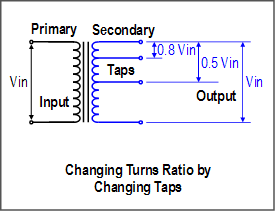Tap Changing Voltage Regulator Operation
 Simply said, when a transformer has an equal number of winding turns on the primary (input) and secondary (output), the input and output voltage should be equal. By adding or subtracting the number of turns on the secondary, the output voltage can be changed – up or down, respectively. Rather than physically changing the number of turns, the turns ratio can be altered by changing the location of the physical connection to the secondary. Transformers often have multiple locations (known as “taps”) for connection to the secondary to adjust the output voltage.
Simply said, when a transformer has an equal number of winding turns on the primary (input) and secondary (output), the input and output voltage should be equal. By adding or subtracting the number of turns on the secondary, the output voltage can be changed – up or down, respectively. Rather than physically changing the number of turns, the turns ratio can be altered by changing the location of the physical connection to the secondary. Transformers often have multiple locations (known as “taps”) for connection to the secondary to adjust the output voltage.

SureVolt™ Voltage Regulator
The SureVolt™ voltage regulator – power conditioner provides the broadest range of protection available to guard your valuable equipment and maximize your bottom line with Industry-leading overload capacity for compatibility with all loads types. Other features include: Built-in surge suppression for surges and spikes, Line isolation minimizes transient events and noise, Transformer shielding further reduces line noise to deliver clean power, and much more.
 The mechanical tap changing voltage regulator utilizes contactors or brushes along with some type of motorized drive system to change the taps on the secondary of the transformer. A simplified diagram is shown at the right. The controller monitors the output voltage and operates the drive system to change taps until the output voltage is within the proper range. There are many variations on this type of arrangement.
The mechanical tap changing voltage regulator utilizes contactors or brushes along with some type of motorized drive system to change the taps on the secondary of the transformer. A simplified diagram is shown at the right. The controller monitors the output voltage and operates the drive system to change taps until the output voltage is within the proper range. There are many variations on this type of arrangement.

